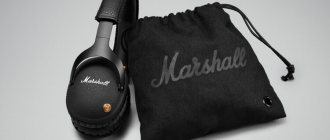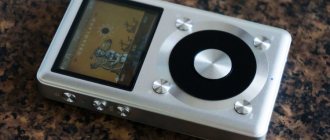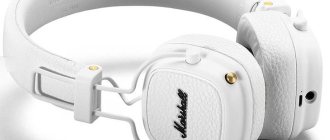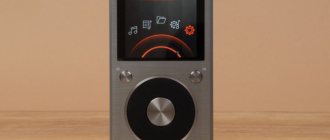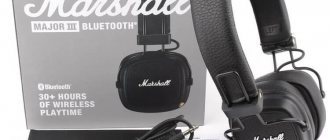Perhaps only a person completely far from the world of mobile gadgets could fail to notice the steady trend of using Bluetooth to output audio streams in modern smartphones. More and more devices are losing the 3.5 mm jack, and more and more manufacturers are offering one or another solution for wireless audio. Of course, FiiO did not stand aside, releasing a wide range of solutions, and today we will talk about their flagship receiver BTR3.
After the BTR1 (the third revision is on the way, by the way) and µBTR were quite warmly received by the market, the time has come to release something more expensive and functional, and this is exactly the model that the hero of today’s review has become. In addition to the improved design and support for almost all existing codecs, it received a couple of nice innovations like the USB DAC function and NFC for quick connection. The AK4376A is responsible for the sound, with which the company’s engineers have already managed to make friends, so the audio component also turned out to be quite up to par. The price, of course, has increased, but within reasonable limits; they are asking about $70 for the BTR3, but the price tag may vary slightly depending on taxes and duties.
Specifications
- Bluetooth chip: CSR8675
- DAC: AK4376A
- Bluetooth: 4.2 with support for codecs AAC, SBC, aptX, aptX LL, aptX HD, LDAC, LHDC
- Frequency range: 20Hz~20kHz by aptX, 20Hz~40kHz by LDAC
- Output Power: 25mW @ 32Ω, 33mW @ 16Ω
- Output impedance: <0.3Ω
- Recommended load impedance: 16Ω ~ 100Ω
- Total Harmonic Distortion+Noise: <0.003% LHDC
- Signal to noise ratio: 120 dB
- Channel separation: ≥75dB
- Input: USB-C
- Output: 3.5mm TRS
- Microphone: Built-in with Qualcomm cVc noise reduction technology
- Battery: 300 mAh
- Charging time: ≤1.5 hours
- Working hours: up to 11 hours
- Dimensions: 58×25×10.4
- Weight: 26 gr.
Packaging and delivery
The box looks like the standard “thin” options from FiiO, but this time it is made not of cardboard but of thin plastic. However, this is unlikely to change anything much. Inside, in addition to the receiver itself, you will find instructions, a warranty card, a USB cable for charging and use as a DAC, and a lanyard for wearing the BTR3 around your neck or somewhere else.
Design and management
There’s probably not much to say about the appearance: a compact block of black aluminum with a glass front panel. Fashionable “2.5D effect” available. At the top of the panel there is an illuminated FiiO logo, which also acts as a universal indicator: it changes colors depending on the codec used and indicates the battery is discharging/charging. I’ll say right away that the idea of changing colors is fascinating; I had fun for about 10 minutes switching codecs in the M7, making sure over and over again that the switching really works.
On the right side there is an on/off button, a microphone hole, a separate “smart” button responsible for play and pause, calling the voice assistant and many other functions, as well as a volume rocker. Short presses on it change the volume, long presses switch tracks. By the way, there is one feature here that looks quite logical to me, but reviews on the Internet say that not everyone shares my opinion. The fact is that pressing the rocker up increases the volume, but at the same time, holding it for a long time causes a transition to the previous track, and this confuses many. For me, this looks logical, since the conventional volume indicator always grows upward, and the list of tracks, on the contrary, goes from top to bottom, so this operation of these keys seems quite normal to me. However, it is almost certain that over time, adjustments for this behavior will be added to the built-in settings utility.
All buttons are made with high quality, they do not wobble, have a pleasant action and a clear click.
Separately, it is worth noting that the BTR3 has its own volume control, which does not affect the device; in theory, this allows you to more flexibly select a comfortable adjustment range. It also does not support headsets, only the built-in microphone and control buttons are used. Here, however, no one promised support for headsets, but for some reason this comes as a surprise. If you bring it closer to your face, the built-in microphone works quite well, apparently, Qualcomm did not develop its noise reduction technology in vain, but at a distance further than “on the collar”, the limitations of a single-microphone circuit make themselves felt.
Like most modern devices, the BTR3 can be connected to two sources and quickly switch between them. Fast Pair mode in Android is also supported; to pair with a compatible phone, you need to press and hold the control button, and then tap on the notification that appears on the smartphone.
Of course, on the “inner” side of the gadget there is a clip for attaching to clothing; it is quite durable, with a good spring.
Both the USB input and headphone output are located at the bottom, so the large 3.5mm plugs are difficult to use simultaneously with a connected USB. USB-C is used for charging, the BTR3 is fully charged in about 1 hour 20 minutes and this is enough for 9-11 hours of active use. This port can also be used to connect the receiver as a USB DAC; in the first version of the firmware, for this you had to enable a special mode manually, but the latest firmware has added an auto-detection mode.
Speaking of firmware, FiiO has already updated the software of this device a couple of times, adding, among other things, the ability to configure BTR3 using the FiiO Music application on compatible devices. There are few settings yet (channel balance, filter, codecs, indicator), but I hope there will be more over time. To install the update you need a computer with Windows, so I also hope that they will add an over-the-air update in the future.
One of the most interesting issues, of course, is the quality of communication. Everything is relative here and depends, firstly, on the sources, and, secondly, on the amount of electromagnetic interference around you. Plus, of course, the codecs used play a role; for example, LDAC in the “sound quality” and “connection reliability” modes differs very noticeably in reliability. In general, I didn’t experience any problems with BTR3, using aptX, AAC and LDAC codecs in the “connection reliability” mode, it easily holds up to 15 meters in the line of sight, if there is a non-main wall with a door, the distance decreases to about 10 meters . Scenarios like “receiver in one pocket, source in the opposite” are handled without problems.
Recently, FiiO began to actively develop the new LHDC codec, which is a competitor to LDAC from Huawei. Its support appeared in both BTR3 and FiiO players. According to the results of experiments, its “stability” turned out to be somewhere between LDAC “sound quality” and LDAC “standard”.
Desktop DAC with WiFi and Bluetooth “Arylic S50 Pro”. We test, disassemble, measure.
Today we have an interesting box for review. The Arylic S50 Pro DAC supports a wide variety of modes and functions: Wi-Fi, Bluetooth, AirPlay, multiroom. Playback from a USB flash drive is also supported. Well, for more convenient control of all this variety of modes, the manufacturer added a remote control. Sound processing is handled by a combination of Qualcomm QCC3034 and ESS ES9023. The cost at the time of review is $175, even cheaper with a coupon. Possible delivery from a Russian warehouse. There was already a review on the site in which the author described the sound of this device. I won’t write anything about the sound, I want to focus on the filling itself and the graphics.
Specifications:
Maximum resolution: 192 kHz/24 bit DAC: ES9023 ADC: AK5720 Bluetooth: Qualcomm QCC3034, bluetooth V5.0, APTX HD, SBC/AAC Housing: metal, aluminum Outputs: RCA, optical, coaxial Inputs: two RCA inputs, RJ45, USB, Bluetooth Internet radio, Multiroom, Airplay, streaming services Wi-Fi: IEEE802.11 b/g/n 2.4G Ethernet: Single 10/100M RJ45 Frequency range: 20Hz - 20kHz Formats: FLAC/MP3/AAC/AAC+/ALAC /APE/WAV SNR: 110dB THD: 0.03% Weight: 400 grams
Arrives in a large cardboard box. On the reverse side are the technical characteristics and features of the DAC.
Equipment: 1. Arylic S50 Pro. 2. Control panel. 3. USB to Micro USB cable. 4. Detailed instructions in English. 5. Two antennas. 6. RCA to RCA cable. 7. RCA cable - 3.5 mm. 8. Power supply 5V 1A.
Micro USB - USB cable is needed to connect to the power supply, length: 110 centimeters.
Power supply characteristics:
No adapters are needed, it connects directly. The plastic control panel is powered by two AAA batteries. The upper insert is made of matte plastic, the lower part is glossy. It just fits perfectly in your hand, very comfortable and compact. The remote control allows you to adjust the volume, select the desired input or output, and turn off the LED on the front panel of the device. It is also worth mentioning that using the remote control you can change the sound character (presets: flat, bass +, bass -, treble +, treble -, d.bass). The AUX IN button allows you to select a line input, both inputs are switched by pressing the button again. In total we have two RCA inputs, you can navigate by the LED on the front panel (yellow or green).
Appearance of Arylic S50 Pro: Front: plastic insert on which the company name and the name of the device are printed. Behind it is an infrared port for the control panel. There is an indicator that, as you already know, can be completely turned off. Yellow or green - RCA line-in White - Wi-Fi Red - USB Blue - Bluetooth At the bottom there are 4 rubber feet and a serial number:
The aluminum case turned out to be of high quality, all connectors are located at the back: Separate antennas for Wi-Fi and Bluetooth, there is a “Reset” button. Two line inputs allow you to switch between two signal sources. You can output sound via a cable through a sound card, from a player or DAC, that’s not the point. Weighs 395 grams (rounded to 400):
The build quality is very good, the board is secured with screws that press against the back metal plate. Disassembling such a structure is a pleasure, a thrill.
The scarf slides into the body on a slide; it does not wobble inside the body:
Two holes are made for the LED and the infrared port.
You can enlarge the photo and see everything on the board:
The back side is blank:
-ESS ES9023 DAC -AK5720 ADC -Qualcomm QCC3034 chip
I’ll put the rest of the macro photos under a spoiler:
Additional Information
There is no 3.5 mm headphone jack. Judging by the previous review, some readers still did not understand why this DAC is needed at all? It's simple, connect the speakers to the RCA output, leave the DAC alone and send a signal. If they wanted, they played music from an MP3 player, from a smartphone via bluetooth or Wi-Fi, or from a USB drive. You can connect the box with a regular computer or laptop through the foobar2000 application (you will need a special plugin).Management is carried out through the 4STREAM application. I turned on Wi-Fi and connected the DAC to my mobile phone. A notification about new firmware immediately arrived. The firmware is updated over the air. In the program you can adjust the volume, switch inputs and outputs, and use the built-in equalizer. The Shanling company has a similar application for Android (with its help you can configure the Shanling UP2/UP4 bluetooth receiver), it is called “Shanling Controller”.
There is a built-in player with a minimum set of functions (rewind, favorites, explorer, shuffle mode). Tapping to the right on the main screen opens an additional menu, this menu has a lot of things: My Music (explorer, playing music from a smartphone, from a memory card). Search. Favorites (favorites).
Streaming services (Pandora, Tidal, Deezer, Qobuz, Spotify) are displayed just below, and there is an Internet radio. I use the Deezer app, all I need to do is enter my account login and password. Internet radio is impressive, as the application has a breakdown by country and genre. Just a huge number of radio stations!
Some services can be disabled if desired; in a special menu we move certain sliders.
What else: the USB drive will be displayed in Explorer, 4STREAM allows you to select the desired input (highlighted with a frame):
I own active speakers with Wi-Fi support (Audio Pro A26). So, in just a few seconds I was able to output sound to the speakers wirelessly. Audio Pro speakers support multiroom technology, like the hero of the review.
What is multiroom technology?
You can play music in several rooms at once. You can adjust the volume in several rooms at once or separately. You can play different music in each room from one application. The same music sounds synchronously in different rooms.
For a snack - graphs. Let's look at the control panel buttons that are responsible for the frequency response. RCA (16 bit/44.1 kHz): FLAT:
d.bass button - affects low frequencies, something like a subwoofer effect. I was not impressed by this mode; the low frequencies sound like a barrel:
Let’s connect the two graphs and look at the differences; it’s worth paying attention to the scale in decibels:
If desired, you can adjust the V-shaped frequency response (using the TREBLE and BASS buttons):
Audiophiles will be able to boost the highs and cut the lows while listening to the fourth violin in the fifth row.
Other results: RCA 24/96:
RCA 16/44.1:
Bluetooth:
Noise appeared, and other characteristics sank:
More detailed measurements (USB drive and Air Play): www.youtube.com/watch?v=Ed1uLzXrOA0 As for the minuses, the application is not exactly crude, but in USB drive mode it often freezes ( that's why I couldn't make additional measurements) In principle, I agree with the author of the above review, we get a multifunctional device with a huge number of settings and capabilities. I agree with the minuses: the RMAA results could have been better. Thank you for your attention.
Sound
The following headphones were used to listen to the device: iBasso IT04, Meze 99 Classics, Audio Zenith PMx2, Noble Kaiser Encore, Campfire Audio Andromeda, Unique Melody Mason V3, HUM Pristine and others.
This time, I probably won’t describe the sound in detail, due to the low meaning of such an activity. The BTR3 plays smoothly, with no pronounced coloration or noticeable problems. More precisely, his main problem is wireless data transmission. The same BTR1, as the main problem, had some syntheticity on VHF and HF, there is less of it here, but in many respects it depends on the codecs used. Therefore, I think it is better to talk about them.
I’ll immediately make a reservation that to compare codecs it is necessary to use only a blind test, otherwise psychoacoustics plays a noticeable role, strongly “correcting the sound” in one direction or another depending on the codec.
SBC The most “basic” codec that has been with us for many years. The sound is approximately similar to MP3 in 128 bitrate compressed with a high-quality codec. After-sounds are lost, the stage is flat, the highs sound like synthetics. On almost any music, except very poorly recorded music, the difference is clearly noticeable, even on inexpensive headphones. Although in fairness, it is worth noting that many telephones sound either worse or not much better over a wire.
aptX Perhaps the most noticeable step forward regarding SBC. The imaginary scene gains depth, after-sounds appear in the lower half of the spectrum, but not all of them, there is less syntheticity in the upper half, but on good headphones it is still noticeable. The lag in quality of the 3.5 mm output of most phones is becoming more noticeable.
AAC Apple's proprietary codec, which suffers largely from the company's tendency not to disclose its technologies. Despite its lossy nature and fairly strong compression in the upper part of the frequency response, it uses some proprietary developments to deceive the ear, which allows it to often sound better than aptX, especially in the lower half of the range. However, on normal music with decent headphones there is still a noticeable difference.
aptX HD An increase in bitrate by approximately 2 times makes itself felt, and the high frequencies especially benefit from this, taking on almost “real” naturalness. There are still not all after-sounds, especially those that should “strive upward”, but here in order to hear the difference you need to listen a little.
LDAC Standard Having briefly compared the three operating modes of LDAC, I decided in the final blind test to limit myself to the average one, as it is the most justified in everyday use, since the “connection reliability” mode in terms of sound tends towards aptX HD, and the “sound quality” mode does not give much increase, worsening the overall reliability of the connection. In general, in the case of LDAC, as expected, the difference is even smaller, but what’s interesting is that it is most noticeable on the high-speed frequency, where some simplification appears. But in terms of processing overtones, this codec is moderately close to a wired connection. The lack of extension in the uppermost high frequencies is also noticeable, but in other codecs it is even more noticeable.
LHDC Codec, almost comparable to LDAC, during the tests I probably couldn’t decide whether it was worse or just different. Probably, it is still a little simpler than the LDAC in terms of processing the low and midrange ranges, but it does the upper half of the range a little better. However, in most genres, the “lower half” still plays a more important role, so for “mass” music LDAC will be preferable, and for “high art” the choice will be determined by the tastes of the listener.
The BTR3 performs very well in DAC mode, almost all wireless transmission artifacts disappear, and what remains is a neutral, dynamic sound with balanced weight and naturalness. Of course, expensive portable DACs will be noticeably better, but as a budget solution for a smartphone or laptop, the hero of today’s review performs excellently.
If we talk about compatibility, the BTR3 is aimed primarily at “plugs” and sensitive full-size devices, which is logical - there is little point in putting a large power reserve in a compact device; it is better to ensure longer operating time and lower noise levels. Of course, there is no absolute “black background” in the BTR3, but even with sensitive IEMs it remains quite listenable. The low output impedance also contributes to good work with multi-driver models.
xDuoo XQ-25 Bluetooth 5.0 Portable DAC (NFC, USB DAC): Best Budget DAC
Hi all! We managed to “touch” the DAC with ES9118 SABER and Bluetooth APT-X - one of the best budget options (under $50) with an amazing price-quality ratio. This new model (XDUOO XQ-25), which replaced the XQ-23, features good sound, NFC for connecting to a smartphone, and a built-in microphone. In general, XDUOO audio gadgets do not need any introduction. And the new portable DAC XDUOO XQ-25 also attracts with an abundance of modern technologies and interfaces: it has a built-in Bluetooth 5.0 receiver with voice communication capabilities (there is a microphone), wireless pairing of devices via NFC. There is also a function that many people love to output audio from a computer (USB DAC).
Characteristics
Brand: XDUOO Model: XQ-25 (
due to spelling errors, the XD-25 marking is found, this is not correct, the XD series of desktop DACs
) DAC: ESS ES9118 with HyperStream Bluetooth: 5.0 with AAC and AptX, QCC3008 Output level: 32 mW at 32 ohm headphone impedance Operating time: up to 7 hours USB DAC: Yes Pairing: NFC Dimensions: 74 x 31 x 11 mm Weight: 34 g
The transport company (SDEK) treated the original packaging very cruelly, sealing it with barcodes and wrapping it with tape. This kind of packaging can no longer be given as a gift (
The kit includes: 1 x XDUOO XQ-25 Headphone Amplifier 1 x USB Cable 1 x Gift box 1 x User Manual 1 x Warranty card
Yes, the kit included instructions. This is a big plus for the Chinese - the instructions are very detailed.
Additional photo of instructions - control keys As for connecting to a computer (remember about the USB DAC mode?) and charging, the kit includes a decent MicroUSB cable.
Appearance of the XDUOO portable DAC
The body is aluminum, with glass on top and bottom.
It looks amazing, tactile - pleasant to hold in your hands. There are also disadvantages - a light piece of soap is ready to jump out of fat little hands. In my opinion, there is a serious lack of a lanyard ring, clip or case. Yes, and the protective glass would not fit. On the other hand, there is no usual display here. There is nothing to protect other than appearance.
On the right are the hardware power and volume +/– buttons (they are also playback controls). At the bottom is a gold-plated 3.5mm audio headphone jack. On the left is a microphone and a MicroUSB interface, which is intended not only for charging the gadget, but also for outputting sound from the computer. This function of an external sound card is called USB DAC and is suitable for listening to sound, for example, from an office computer or laptop in which the manufacturer has clamped a normal sound card. And such gadgets significantly improve sound quality. In general, everything. The design is modest, minimalistic, decent. I like it. The previous model had design issues, but there are no such issues here.
The reverse side bears the markings and NFC antenna icon. Just touch the gadget to your smartphone and the device will be linked.
The indication is poor - only one LED. Discharged or charging - red indication. During operation - blue.
But the size is really small: 74 x 31 x 11 mm.
And also light (about 30 g). There is a serious lack of clothespins or case.
There were no problems connecting via BT, I picked it up right away. Defined as xDuoo XQ-25
Almost all headphones work well - I tried everything that was at hand.
Of course, the sound depends greatly on the headphones. Not so much for the price of the headphones. Different headphones just sound different. Crappy headphones won't sound any better. Well, maybe a little louder. But decent headphones with a good range open up when playing from such a DAC. HyperStream technology in the ES9118 from ESS allows you to hear just a little more. I compared impressions with different headphones, as well as with the Fiio BTR3 DAC (pictured).
Both DACs sound decent. Now I never leave home without such a gadget. In simple terms, the sound has become clearer and fine details have appeared. If we compare specifically with the Fiio BTR3, there is practically no difference, except that the Xduoo XQ25 has more pronounced low frequencies. And if the headphones have a full range with low frequencies, then the result is a very interesting sound, with pronounced details. As for the HF, here the ES9118 plays to its full potential - high frequencies do not disappear when transmitting via BT. This is either a thoughtful DAC setup or high-quality RF compensation. If we compare the sound with conventional BT (TWS) headphones, the sound is much more pronounced, detailed, cleaner and more pleasant.
Well, I’ll also note that the Fiio has a slightly more interesting display during operation. And so it’s almost 1:1, only Xduoo is one and a half times cheaper... Well, the DAC itself in Fiio is different (AK4376A). If we take the new generation Fiio BTR5, then the price is already 3 times different (!!!).
Let me briefly summarize: the gadget is light in weight and compact in size, so it is easy to carry with you all the time. It works quickly and stably (there is nothing superfluous there, the only indication is an LED). But there is support for NFC connection, Bluetooth 5.0 wireless communication, up to 10 meters (standard). Unlike the previous model, the XDUOO XQ-25 has a built-in microphone and supports phone call answering. Among the conveniences is support for displaying the battery indicator in a smartphone via Bluetooth for IOS, Android. Among the useful features is support for a USB DAC for a desktop computer or laptop.
So the Xduoo XD25 is an excellent budget BT DAC. And it's head and shoulders above the previous XQ-23 model.
The product was provided for writing a review by the store. The review was published in accordance with clause 18 of the Site Rules.



